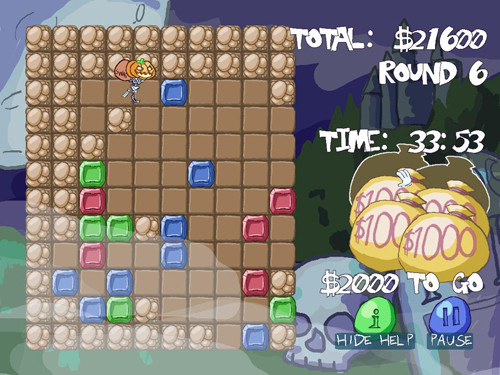独立开发者分享手机游戏《Greedy Bankers》开发经验
游戏邦注:本文原作者是独立游戏开发者Alistair Aitcheson,他拥有自己的单人工作室,身兼程序员、美工和动画师三个角色,他在文中总结了自己在iOS游戏《Greedy Bankers》初级开发过程中的相关经验。
我的iPhone版街机益智游戏《Greedy Bankers》现在已投放到App Store,我很有兴趣借此回顾自己开发这款游戏的一些经历。我的团队就我一个开发者,我得自己全程包揽开发、美工、运营和市场营销等所有事务。《Greedy Bankers》是我投入独立开发者事业以来推出的第一款获利可观的游戏。
我花了两周时间开发试验玩法项目(Experimental Gameplay Project),原本以为只要一个月就能完成iPhone版本的开发工作,但实际上用了三个多月才完成这个项目(游戏邦注:从去年11月初至今年1月中旬)。
虽然免费游戏玩家可能会欣赏你的游戏偶尔闪现的亮点,但是付费玩家却可能对游戏的瑕疵大为反感。所以游戏的用户界面设计一定要简洁而完善,其视觉效果一定得能够吸引眼球,要实现这个目标就得投入相当数量的时间进行编码、测试和调整。
《Greedy Bankers》一开始的定位就是简单而轻量型的游戏,所以对我来说,三个月时间就是开发iPhone游戏的底线,我其实应该再加快步伐。
绘制原图十分耗时耗体
使用我自己画的原图更切合游戏风格,根据以往绘制游戏原图的经验,我估计只要几天就能完成这款游戏的原图,但实际上我用了三周时间才完成了原图。因为我只有先完成了原图,才可能创建倾斜系统和菜单屏幕,所以我在这个环节上遇到了瓶颈。
游戏中的银行家形象设计需要涉及大量的概念绘图法和反馈资料,这样才能塑造出贪婪银行家的形象。而抢劫犯看上去应该是在鬼鬼祟祟地潜行,而不是狂奔不已,这对我来说确实是个不小的挑战。
我现在已经清楚地了解绘制原图确实是个耗时耗体的庞大工程,这意味着未来我开发其他项目时,就会尽量减少游戏中的角色和物体,在不影响质量的前提下,精简动画处理流程。
把握产品完工的时间点
在游戏开发接近尾声时,我又开始担心玩家不能融入游戏的策略环节。我认为应该再添加一些额外功能以鼓励玩家积极探索策略,如果我原来就这么做了,它的游戏玩法还会更人性化。
我之前就已经提到,开发iPhone游戏是一个无止尽的过程。实际情况是,无论添加了多少功能,进行了几次调整,都不会从根本上改变人们对核心玩法的喜好,让完善的产品及时出击市场更为重要。
我的建议就是多观察他人的看法。找一些新手试玩游戏,并根据他们的反应来判断游戏是否达标。采纳这些玩家的意见和建议很重要,但也必须退一步自问,“如果我不那么做,还会有人注意到这一点吗?”或者“这项功能应该跟初级版本一起发布,还是等到更新游戏版本时再推出?”
单兵作战是个苦差事
一人独揽游戏开发到市场营销各个环节的事项,真是一项费时费劲的大工程,但我从来不后悔自己走上独立开发者的道路。
我认为最难应付的一环是,根据实际要求尽善尽美地同时完成各个工作事项。比如说,我一方面得确保游戏角色的原图彻底完工,还要保证代码不出漏洞,同时又得让自己的Facebook和Twitter信息更有吸引力,让我的网站看起来更加简洁明了和专业化。
同一时间处理如此之多的任务确实很让人纠结,如果还有另一个人帮忙分摊工作,可能效率还会更高一点。或许我应该更合理地安排工作时间——例如,在早上进行市场推广,下午再来编码,这样就能保持一种工作的新鲜性和弹性。虽然我还没试过这种效果,但希望下一个项目能如此分配工作时间。
我常告诉自己,这才刚刚开始。我还是需要学习大量的市场营销知识,了解哪种运营策略最为可行。目前还不宜过早判断哪个方法更有助于吸引玩家体验《Greedy Bankers》,所以我现在只能广撒网多布点,尝试各种渠道和方法。
另一个关键问题是,我不清楚App Store究竟是不是这款游戏的最佳投放市场。这个平台拥有庞大的用户规模,其营收潜力无限,但也充满竞争和挑战。我现在面临的挑战就是让这款游戏从中脱颖而出,也许只有时间才能说明最终结果。(本文为游戏邦/gamerboom.com编译,转载请注明来源:游戏邦)
Only the Beginning: Lessons from Greedy Bankers
This is a guest post by Alistair Aitcheson, indie developer behind Greedy Bankers for iOS. A programmer, artist and animator running his own one-man studio, he develops games for iPhone, iPad, web and PC. He writes about his work regularly on his blog, Drawn in Red Biro
Greedy Bankers, my arcade puzzle game for iPhone, is now available in the App Store. This is a perfect time to look back and see what I’ve learned from the development experience.
I am a one-man team, dealing with all aspects of development, artwork, business and marketing. Greedy Bankers is my first commercially available game since starting out as a full-time indie developer.
The demands of a commercial product
Having spent just two weeks to develop the prototype for the Experimental Gameplay Project, I expected the iPhone version to take about a month. The actual development time was in fact over three months, from early November to mid-February.
While freeware gamers will praise you for the bits that seem polished, paying customers will feel ripped-off if the game feels incomplete. The user interface had to be clear and complete, and the visual experience had to be impressive, all of which required considerable time spent coding, testing and tweaking.
Greedy Bankers was always intended to be simple and lightweight, so to me three months is a baseline development time for an iPhone game. I would struggle to do it any faster.
Artwork takes time and energy
Using my own artwork was a conscious decision, as I knew my art style would make my work identifiable. Based on my experience of previous projects, I expected drawing new artwork for the game to take a matter of days. This took over three weeks. As I needed the artwork before I could build the title and menu screens, I ended up with a significant bottleneck.
The banker designs required extensive concept drawings and feedback to make sure they were identifiable as greedy bankers. Animating the robbers to look like they were sneaking, rather than running, was particularly challenging.
I am now well aware of how time- and energy-consuming artwork can be. This means that in future projects I will try to minimise the number of characters and objects I need to draw, and look for ways to simplify the animation process without compromising the quality.
Knowing when the product is ready
Towards the end of development I was very worried that players wouldn’t engage with the strategic side to the game. I was concerned that it needed extra features to encourage them to explore strategies, and that there was more that I could do to make playing more intuitive.
Obviously, had I not drawn the line, this could have been an endless process. The reality was that no amount of features and tweaks would change whether or not people liked the core gameplay, and that getting the product to market was far more important.
My advice here is to always look for perspective. Get new people to play it, and judge from their reactions whether it’s achieved its goals. It’s great to get advice and suggestions, but be sure to take a step back and ask yourself: “Would people notice if I didn’t do that?” Or similarly: “Does this need to be in the first release, or can I save it for an update?”
Being a one man band is hard work
Working alone to develop and market a game can be an arduous and solitary process, although I have no regrets about my decision to go it alone.
The hardest bit is dealing with the demanding requirements on all aspects of your work simultaneously. For example, I needed the artwork to be full of character, the code needed to be bug free, I needed to keep my Facebook and Twitter feeds interesting, and my websites needed to be clean and professional.
Juggling so many tasks can be draining, so it may make sense work in a team with at least one other person, to spread the load. Perhaps I could find a new way to organise my time – for example: marketing in the morning and code in the afternoon – to keep things fresh and varied. As yet I don’t know the solution, but I hope I will by the next project.
So what next?
This is only the beginning, I always tell myself. I still have a lot to learn about the marketing side of things, and which strategies work best. It’s far too early to tell what the best ways to attract players to Greedy Bankers are, so right now I’m sowing seeds in as many places as possible.
The other key question is whether or not the App Store is a viable marketplace for my work. It has a huge user-base, and no upper limit to revenue, but there are a lot of games vying for user attention. My challenge now is to make Greedy Bankers rise above the competition. Only time will tell whether I can make that happen!(source:gamesbrief)








































 闽公网安备35020302001549号
闽公网安备35020302001549号